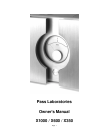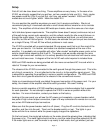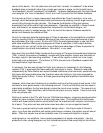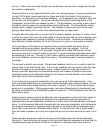Page 3
Setup
First off, let’s be clear about one thing. These amplifiers are very heavy. In the case of an
X1000, we strongly suggest that you get four, not two, people to help you lift it. Yeah, maybe
two people could do it, but if you get hurt, don’t say you weren’t warned. X600 and X350
models are not much lighter, either. Make the dealer lift it.
You can position the amplifier anywhere you want, but it requires ventilation. We do not
recommend placing it in enclosed cabinets or small closets without means for air to circulate
freely. The amplifiers all idle at about 600 watts per chassis, about the same as a hair dryer.
Let’s talk about power requirements. The amplifier draws about 5 amps (continuous rms) out
of the wall during normal audio operation, and this reflects mostly the idle current that we run
through the output stage. If you are driving a low impedance load hard, you will draw more
than this, but this will not be typical. On this basis, we estimate that you can put two channels
on a single 20 amp, 120 volt AC line without problems in most cases.
The X1000 is provided with a special standard 20 amp power cord that is not like most of the
ones you are used to. It is heavier, and mates to a standard receptacle at the rear of the
amplifier. It is probably not compatible with other “after-market” audiophile power cords, so be
sure to check before assuming that it will fit. The power cord we provide requires the more
modern high current wall sockets, so it is entirely possible that an electrician will have to come
out and install new ones. A diagram of the kind of AC wall outlet required is included here.
X600 and X350 models are being provided with the more conventional AC line cord which is
rated at 15 amps for your convenience.
The chassis of the X1000 is connected to the earth ground through the power cord. This is the
only thing it connects to. It is not attached to the circuit or to the amplifier signal ground. This
is essential to operating the amplifiers in series or parallel configurations. The X600 and X350
have their circuit grounds attached to the chassis in the conventional manner.
Under no circumstances should you defeat the ground connection of the power cord. For your
safety, the chassis of the amplifier should be earth grounded. We aren’t kidding.
Series or parallel operation of X1000 amplifiers requires an interface adapter that is essential
for such operation. Do not attempt to operate the X1000 in series or parallel without this
interface. For more information, contact your dealer or the factory.
Looking at the rear panel you will see the AC power cord receptacle, a power breaker switch,
two pairs of high current output connectors, a pair of 5 way connectors for remote turn-on, and
one or two XLR balanced input connectors.
Make sure that the power breaker switch is off (down). Plug the AC cord into the back of the
amplifier, and then into the wall. Then turn the breaker switch on (up). The lights in your
house will dim for a moment while the power supply charges the capacitors.
On the front panel, the single led indicator on the meter should be glowing blue, indicating that
the power is on. The meter lights should not be on, and the meter should be parked at the left.
If the meter lights are on, and the meter is up nearly to half-scale, don’t get excited, just use


















